► We built a Caterham Seven Academy car
► How we got on in the rookie race series
► Full long-term test review and race reports
Twelve months ago I was spending whole days at a time in a cold garage with boxes of parts, a manual and a freshly acquired pile of tools, building our Academy racer. I’d wanted to build a Seven for decades and doing so was hugely enjoyable, if occasionally frustrating (The old build manual was a nightmare: the new one, which looks excellent, is finally here).
The summer that followed, from April through to the last race of the year at Silverstone in October, was one of the most vivid, memorable and rewarding of my life – no exaggeration. There were moments of pure joy. Other moments were genuinely terrifying, and yet more involved a level of stress and anxiety I thought was reserved only for giving a best man’s speech. But the highs – and there were many of them – were incredible, and the reason, I suppose, that this pastime gets under people’s skin, takes over their every waking moment and then gamely tries to bankrupt them.
The highlights? The second sprint event, at Curborough, was rain-lashed, but it was there that I finally began to build my understanding of the car, and a feel for its very sensitive and ultimately hugely rewarding dynamic traits. Our first proper circuit race was at Brands but it was at the next one, on Donington’s rolling curves, that I had my first proper tussle: a dozen enthralling – for me: I’m not saying they made for great spectator viewing – laps of flat-out chess, fending off the advances of rivals/mates David Spare, Jonny Jarratt and James de Lusignan. I came home eighth that day, a hell of an improvement over the 22nd I recorded in the first event just a few weeks previously. The neat bliss I felt on the cool-down lap, cruising down Craner Curves in the late afternoon sunshine, will stay with me forever.
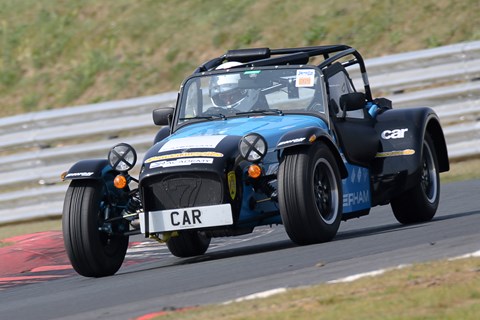
If you’re prevaricating about the Academy, my advice is simple: do it. Hurl yourself into it. Build the car. (Not least because once you have, pre-race checks and maintenance are child’s play.) Choose your race gear and feel like the real deal. Book trackdays. Make mistakes. Really understand weight transfer, lines and drafting. Find a great driver coach (Darren Burke is excellent – darrenburke62@aol.com). Get faster. Experience unfettered joy and relief. Go in cynical and come out with a bunch of new friends. Catch some slides, lose others. And at the end of the year wonder two things: what took you so long; and how on Earth you can find the funds to continue.
By Ben Miller
Logbook: Caterham Seven Academy
Engine 1595cc 16v 4-cyl, 125bhp @ 6100rpm, 119lb ft @ 2500rpm
Transmission 5-speed manual, rear-wheel drive
Stats 5.0sec 0-60mph, 122mph, n/a g/km CO2
Price £24,995 (includes race season)
Miles this month 112
Total 2238
Fuel this month n/a
Extra costs None
Month 11 racing a Caterham Academy Seven: Silverstone!
You’re not supposed to like Silverstone, just as you’re not supposed to like dark chocolate Bounty bars. But I adore the place, both in driving games and, it transpires, in real life. In qualifying for the last race of the season (where did that year go?) I bagged eighth on the grid, a PB.
In the race I could see the lead pack for a good few laps but drove like a big girl’s blouse on the last lap to come home tenth. Note to self: be more Verstappen in future, elbows out.
By Ben Miller
Logbook: Caterham Seven Academy
Engine 1595cc 16v 4-cyl, 125bhp @ 6100rpm, 119lb ft @ 2500rpm
Transmission 5-speed manual, rear-wheel drive
Stats 5.0sec 0-60mph, 122mph, n/a g/km CO2
Price £24,995 (includes race season)
Miles this month 217
Total 2126
Fuel this month n/a
Extra costs None
Month 10 of our Caterham Academy race car long-term test review: racing when it pours at Rockingham
Rockingham’s International Sportscar Long layout uses the first of the circuit’s four banked turns, adding a unique complexion to a circuit that often struggles for appeal with the likes of Silverstone, Donington and Snetterton all less than two hours away.

In an Academy-spec Caterham the banked corner is taken flat-out in fourth gear when it’s not raining, the ideal line being just inside the white line that denotes the track limit. But throughout the qualifying session for our recent race at Rockingham, round six of the championship, it was raining; hard. Wipers-going-full-bore-but-making-no-difference raining.
Turn one became a lift and a gentle re-application of a steadying throttle once into the corner, with the ideal line a little higher on the banking to steer clear of the friction-free rubber on the normal racing line. Fine, until you pass over the dry line towards the end of the corner, revs flare, and the car kicks sideways at 90mph. Good times.
The 15-minute session was an all-consuming lesson in low-speed, zero-grip car control, with more slides provoked and clumsily caught than in the rest of the season combined. Come the chequered flag I was tenth fastest, my best of the year, and the spread of times a reflection of just how tricky the conditions were. The pole time was a full 10 seconds faster than my best, while my best was 20 seconds faster than the back of the grid.
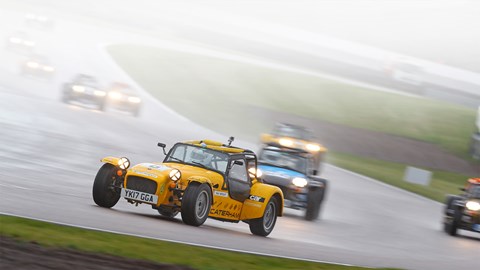
Back in the pits we were divided 50:50, with half of our group smiling like they’d had the time of their lives and the other half hoping to God they’d never have to drive in conditions like that again.
By Ben Miller
Month 9 living with our Caterham Academy car: just a little fettling…
A little quality garage time with the Seven this month. One headlight had worked loose, low brake fluid was prompting a dash warning light under acceleration and Caterham supplied us Academy drivers with a new pedal to try to improve on the non-existent brake feel.
A happy couple of hours’ spannering had the car race-ready again ahead of our next outing at Rockingham, while a trip to the outstandingly old-school Careby Garage saw my Seven’s wonky tracking put back to the recommended – and hyperactive – 2° of toe-out.
Logbook: Caterham Academy
Engine: 1595cc 16v 4-cyl, 125bhp @ 6100rpm, 119lb ft @ 5350rpm
Transmission: 5-speed manual, open differential, rear-wheel drive
Stats: 5.0sec 0-60mph, 122mph, n/a g/km CO2
Price as tested: £24,995 (includes race season)
Miles this month: 214
Total miles: 1746
Fuel this month: £N/A
Extra costs: £20 (adjustable spanner, brake fluid, split pin)
Month 8 living with our Caterham Academy car: better on road than you expect
In early August I raced at Snetterton. Since trailers are expensive, the circuit just a couple of hours from home and the Seven road legal, I drove to and from both the Friday test day and Saturday’s qualifying session and race.
This is, I tell myself, the stuff of legend. Proper grassroots, keeping-it-real motorsport. But it’s also about engineering as many opportunities as possible to drive and enjoy what is an addictively brilliant road car. We’re all busy people. The time to sneak out in the Caterham for thrills alone is rarer than lithium in Elon Musk’s back garden. So why not use the car for every journey you have to make?
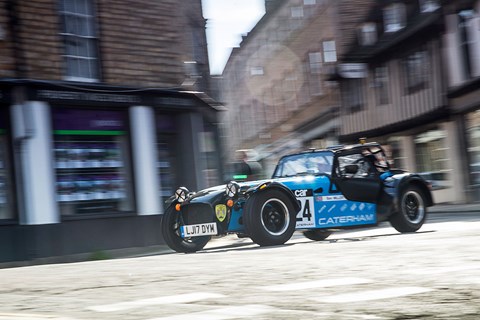
When the alarm goes at 5am it’s easy to find yourself questioning the above logic. A long, early and dull journey should show the Seven in the worst possible light, and I’m not going to argue it’s in any way refined. The transmission whine is endless and, with no heater, you’re invariably too hot or too cold. There’s nowhere to put your feet other than on the pedals and the car rattles like a shot-up Lancaster. Windows, cruise control, a radio and nav are pipe dreams.
And yet on that Saturday morning, while most of the rest of the country was still asleep, I snuggled down into my harness on the A1(M), watched in awe as the amber dawn sun lit up the countryside and, with a smile on my face, cruised with my brain and soul in a state of pronounced happiness.
Qualifying at 9am was a rude awakening but a joy nonetheless; if you haven’t driven the 300 Snetterton layout, you must. I started the race 12th and, after some nice little dices and a slightly frustrating lack of aggression/ambition on my part, that’s where I finished. A mate came to watch on his Ducati, so after the race I threw my race support infrastructure into the car (fuel can, torque wrench, kitbag, pop-up camping chair) and we headed off for some lunch.

The morning’s perfect summer weather vanished, replaced by slate skies and rain, and on fast, challenging and apparently lawless Fenland roads our unlikely convoy (£17k of fully-loaded Ducati, with switchable engine modes, electronic suspension, traction control and ABS) and similarly priced little British sports car (none of the above) sped west, blasting past less impatient traffic and revelling in the challenge of maintaining such a lively rate of progress in sodden conditions.
The race was great fun but the drive home better still. The Academy-spec Caterham is a racing car first and foremost, and if you can only run one road car you’d have to be laudably nuts to choose it, but it’s a special machine precisely because it is so fun-focussed. You slide into it, you faff with the ignition and the six-point harness for what feels like hours and then you just drive.
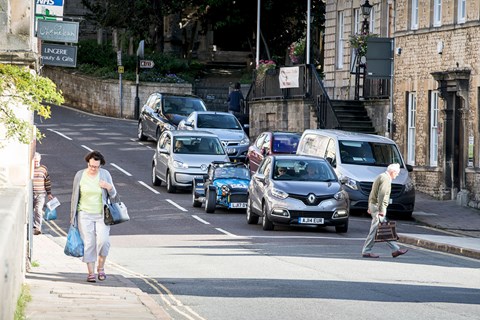
You drive and regardless of the road are never, ever bored. It’s the way the car endlessly fidgets about; in your hands, through the wheel, and on the road. It’s intoxicatingly physical. The passing slipstream tugs happy tears from your eyes. You smell everything; diesel fumes, the distant harvest, hot tarmac.
The roar of the exhaust inches from your right ear is sweet, sweet music.
I can only describe it as a kind of furious, kinetic hypnosis: your brain high as a kite on sensory saturation while your body happily busies itself with the calm, precise inputs the car demands.
Addictive? The cold turkey that must come with the end of the season and the car’s return to Caterham is already filling me with dread.
Caterham Academy: the essential options
1. Ear Defenders/Radio: £60 for something similar
Bought at Le Mans to keep on top of the race, these have since proved brilliant in the Seven. Block out most of the din, even at motorway speeds, and tune in to Annie Mac if you fancy it.
2. Video vBox Lite: £1194
Academy regulations require front and rear-facing cameras, and a VBOX is invaluable as a driver aid for recording and showing lap times during sessions. GPS speed readout handy on the road with the speedo packs up, too.
3. Bead seat: from £850
I’m just over 6ft tall, so in the standard Seven Academy seat my head is too close to the rolllcage for safety. The bead seat (bags of polystyrene beads are formed around you and set with a resin, then trimmed and upholstered) gets me race-legal.
By Ben Miller
Logbook: Caterham Academy
Engine: 1595cc 16v 4-cyl, 125bhp @ 6100rpm, 119lb ft @ 5350rpm
Transmission: 5-speed manual, open differential, rear-wheel drive
Stats: 5.0sec 0-60mph, 122mph, n/a g/km CO2
Price as tested: £24,995 (includes race season)
Miles this month: 258
Total miles: 1532
Fuel this month: £87
Extra costs: None
Month 7 in the Caterham Academy: top 10!
Ninety words to tell you about 15 of the most exciting minutes of my life. Here goes. Donington, full circuit. Race two of the Academy season. Qualified 13th. Pre-race, Caterham’s Simon Lambert asks if I fancy a top 10. Yeah, right. Okay start, good first lap. Six-lap battle for tenth, mostly with David Spare but James de Lusignan and Jonny ‘Spinderella’ Jarratt get involved too. Break clear of the dogfight for the last couple of laps. A retirement and last-lap spin up ahead promote my tenth to eighth. Euphoria.
By Ben Miller
Logbook: Caterham Academy
Engine: 1595cc 16v 4-cyl, 125bhp @ 6100rpm, 119lb ft @ 5350rpm
Transmission: 5-speed manual, open differential, rear-wheel drive
Stats: 5.0sec 0-60mph, 122mph, n/a g/km CO2
Price as tested: £24,995 (includes race season)
Miles this month: 37
Total miles: 1274
Fuel this month: £35.42
Extra costs: None

Month 6 living with a Caterham Seven Academy car: in the thick of it
Into the holding area for my first ever race and the cool calm that miraculously took hold for qualifying (14th from 25) has deserted me. My heart’s going so hard I’m worried the valves might bounce.
After an age – engine running, sweat boiling up inside Nomex – we form up on the grid. In a heartbeat we’re off around our warm-up lap of the short, sharp shock that is the Brands Indy circuit. Then it’s back to the grid, red lights on, red lights out… Go.
The journey here’s taken six months. Late last year I took delivery of a Caterham Academy car in kit form. In the post-Christmas winter months I did my race licence, bought a lot of expensive equipment (around £2k on race suit, fireproof undercrackers, Hans device, boots, gloves, helmet) and, as the big chill mellowed into spring, we tackled a couple of pre-season events and two competitive sprints (21st of 26 in the first, 14th in the second) – all preparation for this, our first proper race (the Academy is only open to racing virgins).
Wheelspin – what feels like a good 10 minutes of wheelspin. Up to second gear, hit the limiter. Then somehow I’m through edge-of-the-world Paddock Hill with a decent turn of speed and without incident.
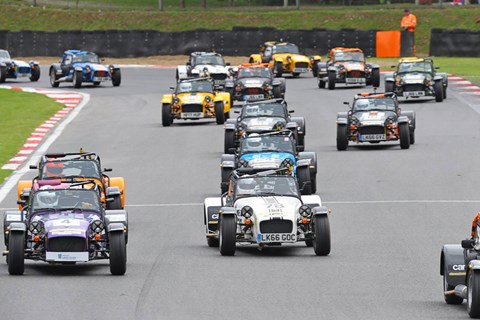
Through Druids, down to Graham Hill for the first time and as three cars battle themselves wide of the racing line I drive through to eleventh, then tenth on the run to Surtees. At this point I remember to breathe again.
The car tightens as the rubber comes up to temperature, the gap to the gaggle ahead shrinking as their infighting hurts their lap times. At Druids I’m close enough to think about a pass, move wide for a faster exit and… drop the clutch so gracelessly on the shift down to second that the already light rear end slews round in a half-spin.
Poor Ryan Scarratt flies into the corner behind me to be presented with very few options: go left for gravel, straight on for a Caterham broadside or right for salvation – if he can make it. He nearly does, then there’s a thump as his rear suspension meets my front wheel. I lose a couple of positions before getting underway again, so angry at myself I don’t even notice one bug-eye lamp pointing lazily at the sky.
Over the next dozen laps I try to stay calm and make up a couple of places. At the front an epic scrap between Dan French, Matt Sheppard, James Murphy, Caterham CEO Graham Macdonald (know thy product…) and fastest-lap man Toby Clowes keeps the crowd on the sun-drenched banks happy.
Dan takes the chequered flag. I cross the line for 12th, the overwhelming joy of having finished tempered by the fact Ryan’s car made it no further than Druids – this racing thing is intense.
By Ben Miller
Logbook: Caterham Academy
Engine: 1595cc 16v 4-cyl, 125bhp @ 6100rpm, 119lb ft @ 5350rpm
Transmission: 5-speed manual, open differential, rear-wheel drive
Stats: 5.0sec 0-60mph, 122mph, n/a g/km CO2
Price as tested: £24,995 (includes race season)
Miles this month: 562
Total miles: 1274
Fuel this month: £122.90
Extra costs: None
Month 5 living with a Caterham Seven Academy car: road-legal and summer-ready!
After an agonising wait for paperwork and number plates, the dreamy day that powered me through a winter of lonely self-
assembly in the garage finally arrived. Our Caterham Seven Academy was finished in time for the series’ first official pre-season event at Donington Park, but two admin errors by the DVSA meant road legality eluded it for a further two months. A perfect spring day and a Caterham you can’t use is quite exquisite agony.
But yesterday the number plates arrived. Last night I stuck them on and did my pre-event routine: a diagnostic run over the car with the torque wrench, a check of the kitbag and a glance at the tyre pressures, oil level and brake pads.
This morning the alarm went off
at 5.30am. A cloudless blue sky and a Technicolor sunrise promised the best weather of the year so far. With tools and race kit wedged into the passenger seat and earplugs in, I nosed the Seven out of the drive and onto the road for the first time (ish – we don’t talk about the shakedown).

There’s nothing exciting about the most efficient route from Stamford, Lincolnshire to the Snetterton circuit, but to drive it in a car you built yourself, that you’ve never driven on the road before, on a flawless May morning, with the promise of an open-pitlane trackday when you get there, is to smile for whole chunks of the A14 – something that’s never happened before in the history of mankind, and never will again.
On the road the Academy is loud, alive, tiny, vulnerable and mighty. The way it moves is unique, feeling both floaty (thank soft suspension and tyres with actual sidewalls) and yet connected with a thrilling immediacy unlike anything else I’ve driven. It also feels fast on the road in a way it doesn’t always on a track unless you’ve screwed up and lost control. On a B-road, with closer reference points and less margin for error, the sensation of speed is cranked right up, at least until drag kicks in with a vengeance at 80mph.
I spent the day chipping away at the fast, technical and spectacular Snetterton 300 circuit, dodging two 911 GT3 RSs and weaving through a mixed field of wobbly road cars (skinny-tyred Ford Puma, slick-tyred 306 GTi-6) and some really nicely driven Lotus Exiges. The drive home, sun on my face, was a blissed-out hour-and-a-half of almost transcendental happiness. If I’m getting carried away, apologies – Caterham life will do that to you.

At a fuel and water stop half an hour from home (water for me, not the car – one of the great things about the Seven is its ability to pound road and track for thousands of road miles without complaint, thanks primarily to weighing nothing), a chap in a Transit van strolls over, smiling at the Seven’s dinky size but serious-looking spec.
This happens a lot with a Caterham, especially an Academy car. And as you tell them about the one-make series, about how it’s almost affordable (£25k, but you keep the car worth around £19k at the end of the season), about how it takes you through every stage of the process (licence, tuition and myriad little but crucial things, like how to properly belt into a six-point harness) and above all how it makes motorsport almost fair, with identical cars on identical tyres, you see them doing the maths and getting excited like a kid at bedtime on Christmas Eve.
Seven racing: how spicy do you like it?
Academy
Where it begins. A season costs £24,995 including entry fees, the car, tech support and your licence. Doesn’t include kit, fuel (obviously) and some stuff you’ll need, like a decent toolkit and cameras for your car (regs require forward- and rearward-facing video cameras). Open to racing novices only.
Roadsport
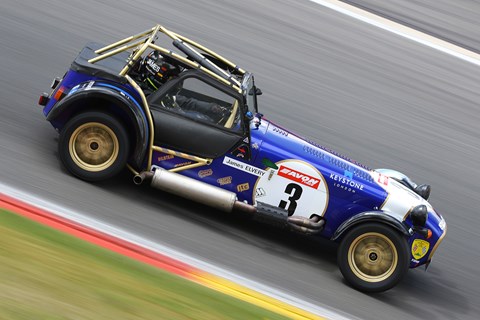
Where Academy graduates keen to continue go next. Cars are based on Academy machines, modified with stickier tyres, a rear anti-roll bar and a more feelsome brake master cylinder. Cars retain their windscreen and road legality.
270R
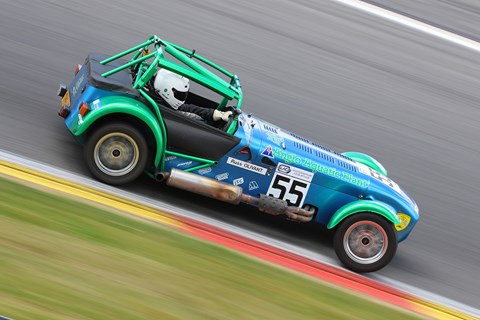
Getting serious. Comprehensive wide-track suspension upgrade, windscreens are binned for aero screens (drag reduction boosts speeds) and the rev limit’s raised from 6800rpm to 7200rpm for more power. Lights come off but you can re-fit them for road legality. A £2000 leap from Roadsport.
310R
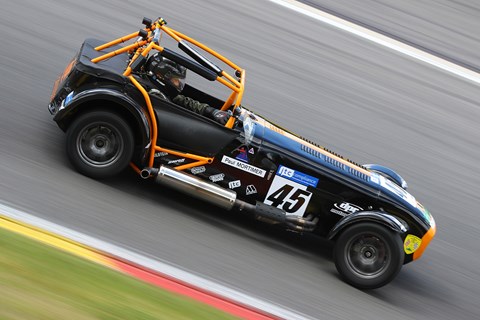
Power climbs again thanks to revised camshafts and a new intake system, plus in comes a limited-slip differential for improved traction and throttle adjustability. The highest class to which you can take your original Academy machine.
420R
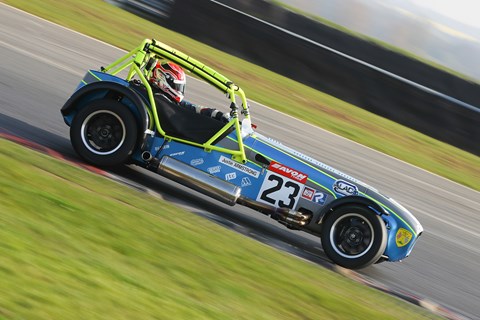
Top of the Caterham tree and a proper race car: datalogging dash, 175bhp, limited-slip differential, bag-style fuel tank and the incredible six-speed Sadev sequential gearbox used by the top-of-the-range 620R road car.
Engine: 1595cc 16v 4-cyl, 125bhp @ 6100rpm, 119lb ft @ 5350rpm
Transmission: 5-speed manual, open differential, rear-wheel drive
Stats: 5.0sec 0-60mph, 122mph, n/a g/km CO2
Price as tested: £24,995 (includes race season)
Miles this month: 234
Total miles: 712
Fuel this month: £51.17
Extra costs: £179 (Javelin trackday, Snetterton)
Month 4: pre-season testing in the Caterham Academy – the highs and the highs
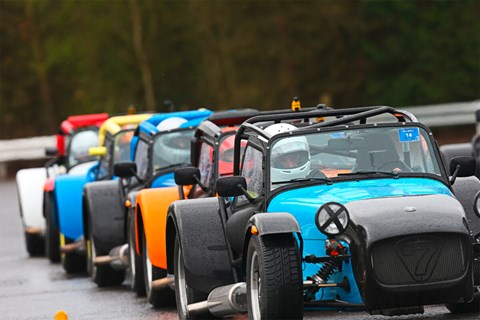
Finished, just in time
With, ahem, a little help from Caterham technician Alex Betts, the car was finished in time for the pre-season Handling Day at Donington Park, a key date in the finely honed Academy programme that teaches car control, standing-start technique and passing scrutineering without rejection and tantrums.
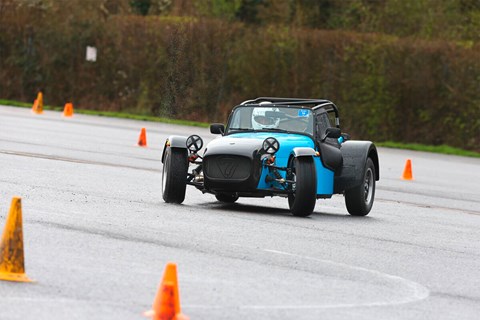
We meet at last
Two admin errors on the part of the wretched DVSA, keepers of the Individual Vehicle Approval (IVA) test required to make the Caterham road-legal, meant that I completed just a handful of miles in the car (don’t ask where) ahead of the Donington Handling Day. Nonetheless I had a blast wildly flailing between cones in a consistent Midlands drizzle, 1.6-litre Ford power regularly overcoming Avon grip…
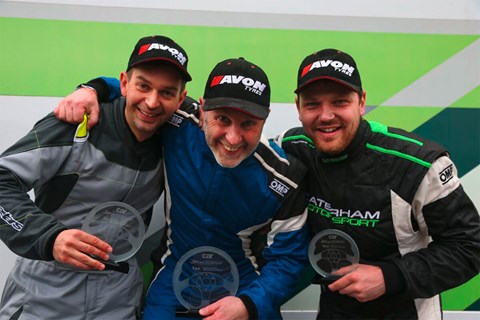
You what?
…and managed to leave myself gobsmacked by setting the second-fastest time in the timed slalom event at the end of the day, just a tenth behind winner David Spare (blue overalls, big grin). I can’t offer any explanation for this but took the natty branded Avon Tyres cap, the fetching glass trophy and the sporting congratulations of my equally gobsmacked Academy classmates nevertheless.

Back down to earth
Next came a test day at Castle Combe, run in sessions like a trackday (20 minutes on; 40 minutes off, thinking about tyre pressures, fuel, racing lines and how much faster everyone else is). The hours streamed by in a haze of euphoric highs (‘I’m on a track, going as fast as I can, in a car I bolted together!’), a couple of moments of blind panic and periods of sober contemplation – I have a lot to learn.
Logbook: Caterham Seven Academy
Engine 1595cc 16v 4-cyl, 125bhp @ 6100rpm, 119lb ft @ 5350rpm
Transmission 5-speed manual, open differential, rear-wheel drive
Stats 5.0sec 0-60mph, 122mph, n/a g/km CO2
As tested £24,995 (includes race season)
Miles this month 114 Fuel this month £24.69
Extra costs £100 (trailer hire)
Caterham Seven Academy diary notes month 3: the winter of content (self-assembly part 2)
It’s in!
Engine installation was covered in a magazine update but I didn’t have the space to go into much detail. I learned this doing the job:
1. Straps, not chains
HSS suggested chains but they’re difficult to set to the right length. I went with tie-down straps, so I could easily adjust their length to suit. The engine block has a couple of obvious lifting points but you need to take the time to ensure the straps won’t put pressure on any vulnerable parts of the engine once they take up the slack – engines can be painfully and expensively damaged if you’re unlucky.
2. Angle is key
You lift the gearbox high, wheel it in over the front of the car, drop the far end (where the propshaft will be) down into the engine bay and lower as you continue to push the whole rig towards the back of the car. On the first attempt, I dropped the propshaft end too low, hoping to swing that end up into the transmission tunnel… Didn’t work. Also, the manual suggests lining the inside of the tunnel with cardboard for protection. Believe it or not the final fit is so snug there isn’t really space to do this!
3. Gentle perseverance required
On the second attempt the gearbox went into the tunnel and, despite looking like it’d never fit (the engine mounts I’d pre-fitted had to come off), the engine finally dropped into the bay. Bolting it into place is easy enough, with just bolts at the front – of a weird imperial size – and a meaty plate up under the gearbox, fixing the gearbox in place. After perhaps four hours, we were done.
4. Use a mate
I had a really handy one, Ped Baker, who’s so fluent with tools he builds beautiful bicycles in his spare time and considers making bespoke motorcycle swingarms with pornographically neat welds a leisure pursuit. At 3pm, Ped and I went to the pub. Cheers, Ped.

Love the exhaust…
Installing the exhaust system was by a country mile the easiest, most satisfying part of the build. The downpipes look like a tight fit but the manual’s clear on which one goes where, and in which order to poke them through the square hole in the side of the car. Soon the header bolts are loosely installed and you’re adding pipework and back-box. Within an hour, you’ve tightened everything up and given yourself a big pat on the back.
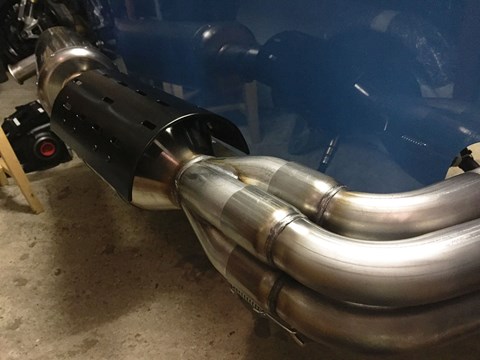
…hate the diff
What could be simpler? Bolt the propshaft to the back of the gearbox, and fit the diff up into the rear of the car before bolting the propshaft to the diff. Fine, except that you also have to route the handbrake cable at this point, complicating everything. The diff also mounts to the diff carrier on bolts requiring spacers, and the diff itself must be lifted up from underneath the car and is really, really heavy.
I probably lost a week messing about the diff, and fitted it twice only to have to remove it again. There’s a mount on the underside of the chassis that looks perfect for the handbrake cable, but it isn’t the mount you’re looking for. The handbrake cable mount is actually on the diff, I know now… As for actually getting the diff up into position, and holding it still while you slide the bolts in… The manual says use a jack. I found the curved castings of the BMW 1-series differential made doing so tricky. So I squatted down by one of the rear wheelarches and lifted it into position while my girlfriend poked the bolts through; an exhausting solution perfect for cultivating heated argument. For the successful third attempt, I lay under the car and bench-pressed it up into position while our eldest son did the honours with the bolts; much easier. And actually, the spacers weren’t too bad, their installation eased by a tip from the Facebook group; use copperslip grease to stick stacks of them together for assembly.
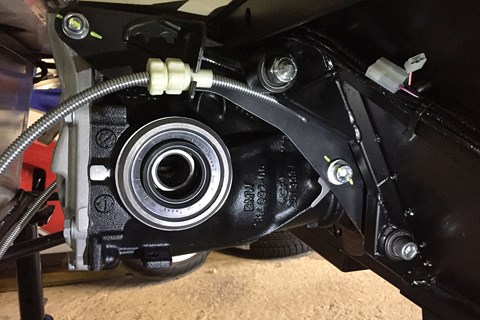
Back to the front
With the rear taking shape, I popped back to the front of the car to fit some stuff like the steering system and engine ancillaries, including coolant hoses and the header tank. All pretty easy, with a couple of hours spent hacksawing hoses to length, cleaning up the cuts and slowly working my way through a monster bag of jubilee clips. Also easy was the air filter and associated plumbing – a joy after the heavy-lifting of the diff.
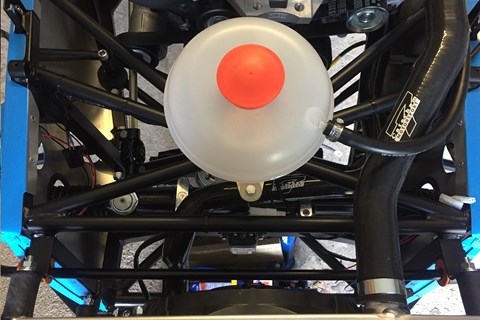
Rear suspension
What the hell is a De Dion tube? How does it work? Now I know, thanks to a weekend spent assembling the Seven’s rear suspension and driveshafts, a confection of tubes, control arms, dampers and really gorgeous machined aluminium parts; some of the nicest components on the car.
First off you test-build the De Dion tube and rivet the brake lines to it. I’ve never riveted anything before. It’s fun, though if you do it on the dining room table, little bits of rivet will turn up at mealtimes for months afterwards.
Then you take the end plates off the tube again, fit the tube, install the drive shafts, re-fit the end plates and… suddenly you’ve got rear suspension, rear hubs and, in a madly exciting rush, four wheels and tyres on and, with the axle stands out for the first time since the day of delivery, a sort-of car sitting on its own rubber.

By Ben Miller
Month 2 in the Caterham Academy: like school, but fun
‘Power now! All the way out to the edge of the track, relax the steering. You’re holding a tighter line than you need to; fine in a Fiesta but in a Caterham you’re going to have a lot of oversteer!’
And so my meagre bank of circuit driving experience gains another 20 minutes of data to file under ‘Castle Combe, wet, Fiesta’. But where I am, at the bottom of the curve, every second is full of learning, even in a session that’s essentially a driving test – the practical element of the test for a National B licence. On track we’re given a handful of smart and smooth laps by our instructor, three of us Caterham Academy scholars crammed into the car like we’re on a particularly spirited sixth form lunch run to McDonald’s, then rotated through with 20 minutes each at the wheel.

There’s little reason to go fast since a spin is a fail, no questions asked. But you’re on a track in a car, so of course you go almost as fast as you can. And instructor Erling Jensen being a racing driver (a wrenchman for British Leyland on the works Mini Coopers, twice British Rallycross champion and a GT champion at Combe), he does all he can to help me go faster, with particularly good advice on the pros and cons of even subtly different lines, the benefits of smoothness and good forward visibility, and the importance of respect; for others, for the track limits and for Castle Combe on a wet February day in near-freezing temperatures.
The brilliantly organised Academy (uk.caterhamcars.com/motorsport/academy) being what it is, this is getting your licence the easy way. Caterham books the dates, hassles you to complete the paperwork, issues instructions (learn your flags – you must score 100% on them in the written test) and uses the opportunity to make the day useful and fun, with a car control lesson on a skidpan in an abused 3-series and a session on preparing your Caterham for racing (where to put the tow-strap, how to properly secure your harness, sealing your boot/fuel tank compartment against fire…).
Plus it’s an opportunity to meet your Academy classmates for the first time. Mine are pretty much as I expected: keen on cars (the car park’s peppered with Porsches, an Evora 400 and a BMW i3); lots of talk of ‘if not now then when?’; and universal relief at finally being racing drivers.
By Ben Miller
Caterham Seven Academy diary notes: the winter of content (self-assembly part 1)
I’ve wanted to build a Seven from kit form for as long as I can remember, the notion of bolting together my own example of the lightweight and very British sports car feeling like a natural extension of the years spent messing about first with Lego and then with Tamiya radio-control buggies.
In my first magazine update I talked a little about the joys and challenges of the build in the broadest terms – here are a couple of random stages from the process, one that Caterham reckons should take between 80 and 100 hours. Having since compared notes with other Academy colleagues who elected to self-build, that feels about right. I probably put in 50 hours across nearly three months, in evenings and weekends, and got perhaps 70% of the way there – Alex at Caterham South finished the job, and even took the time to be far less rude about the quality of my workmanship than he could have been.
The big day
This, as I’m sure you’ll appreciate, is a pretty special moment. You’ve signed on the line, agreed a delivery date, taken delivery of the dedicated Draper toolkit (£475, and well worth budgeting for unless your garage is already very well equipped) and cleared the garage in anticipation.
Then a lovely man in a truck turns up and drops off the mother of all model kits. It’s the first chance to see whether you’re happy with your colour choice (Porsche Riviera blue, and very much so, fortunately) and to check out some of the Academy car’s unique parts, such as the very racy Tillett seats, impossibly big 1.6-litre Ford Sigma engine and the faintly terrifying low-grip, big-tread Avon tyres. You and the delivery driver then effortlessly carry the chassis from the truck to your garage – which tells you all you need to know about how much you’re going to love driving this thing.
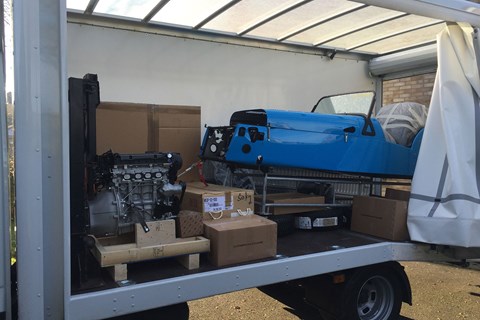
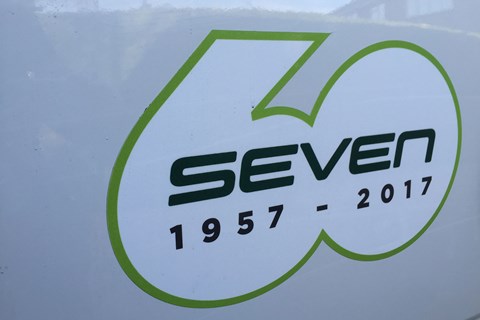
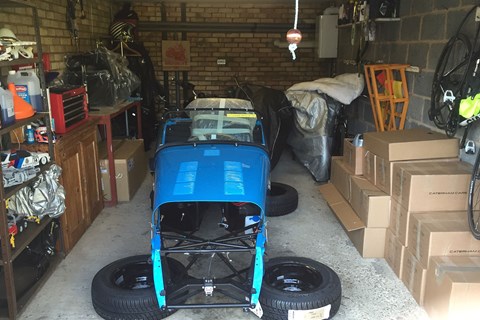
It begins
Full of trepidation you re-read the instructions, pluck out the steering rack and its fasteners (all fasteners are bagged according to the sub-assembly with which they’re relevant, together with an ID sheet that isn’t always crystal clear…) and loosely bolt the rack in place – it’s tightened later. Well, that was easy enough…
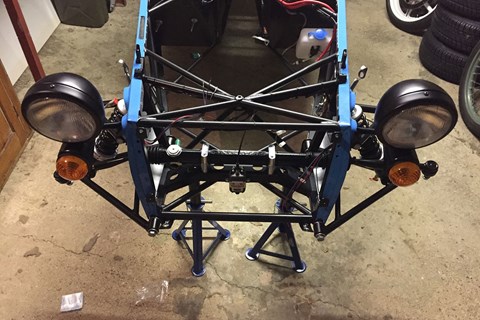
Bloody spacers
Next up, front suspension. Wishbones are easy to find, as are the nuts and bolts you need. Easy-peasy… Except that the Seven’s big on spacers, and the instructions always ask for one more than can comfortably fit in the gap in question. And so you get busy with gloved hands and a screwdriver for leverage, working away to get washers in where they’re not hugely keen on going…
Helpfully, the headlight strut is also integral to the upper wishbone mounting – you only install the wishbones without the struts already in place once… Fitting the dampers is hugely satisfying, as is liberally smearing copper grease everywhere in the pretty nonsensical belief that it’ll make your car handle more sweetly than everyone else’s…

You’re in the way!
The car’s been in production sixty years but you still have to physically bend (admittedly thin aluminium) bodywork out of the way at this point to get the upper damping mounting bolts in position. Amazing. (Later on, rubber IVA strips are applied to all these raw metal edges).

Big bits, part 1
Really early in the build you prep the powertrain and fit it to the car. These stages are relatively easy and really satisfying: big fasteners, easy access, no spacers and little to leave you confused. Gearbox is five-speed on the Academy cars.
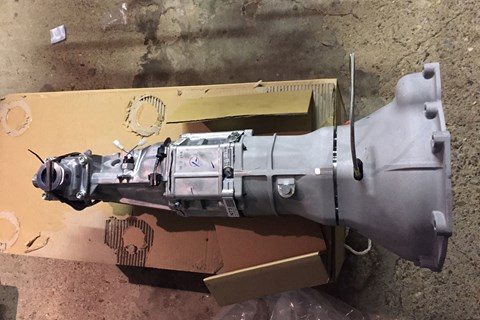
Big bits part 2
With the gearbox bolted to the bellhousing, the bellhousing’s then bolted to the engine. Note cold, dark December weather outside.
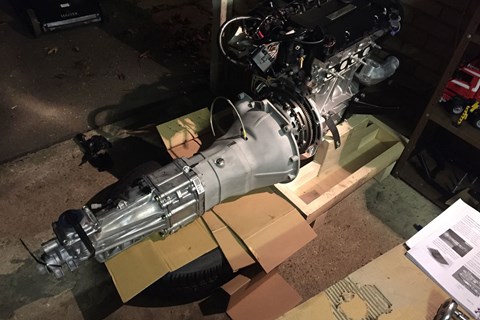
By Ben Miller
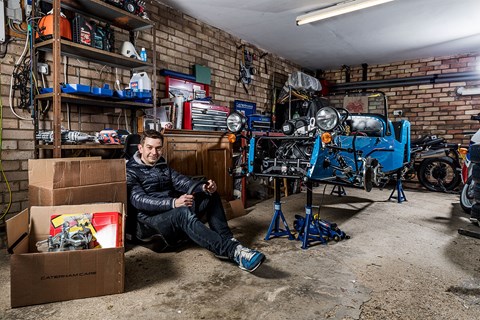
Month 1: building our Caterham Academy Seven race car
When it’s good, building a Caterham is really, really good. I’ll give you an example. It’s the no man’s land between Christmas and New Year. Much of the world is furiously approaching bankruptcy in the ‘sales’, hitting retail parks like Viking hordes descending on a coastal village in Yorkshire. Me, I made a coffee, slid into the garage before the rest of the house was even awake and stuck on the radio.
Then, for five hours, I methodically took parts – clean, unblemished, rust-free parts – from labelled boxes, checked nuts, bolts, washers and spacers against build sheets and, using a pretty impressive suite of equally fresh and unabused tools, built part of a car. The front suspension and steering, in fact; rack, wishbones, dampers, track rods – the lot.
During those five hours I thought of nothing other than what I was doing, except for a couple of moments in which I thought about cake. And when I felt I’d reached a suitable point at which to call it a day, I headed inside aglow with the satisfaction that comes only with achieving something tangible with your hands, your brain and some physical tools.
Roughly half of the UK’s Caterham buyers self-build and, in moments like this, you wonder what on earth the other 50% were thinking when they stumped up £2500 for a factory build.
Building a Caterham DIY: when things don’t go well…
When it’s not going so well, building a Caterham can be a little frustrating. The manual uses many, many words, not many pictures and an at once logical but unhelpful running order. A new manual is, you’ll be pleased to hear, in the works. Caterham has recognised the sheer brilliance of the instructions you get with a Tamiya radio control car.
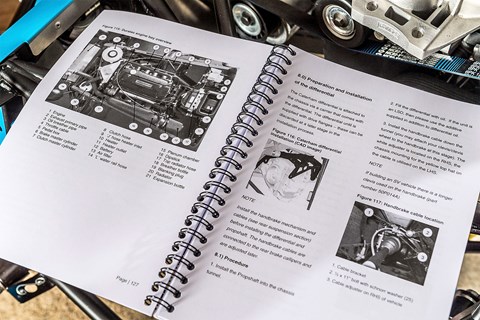
These kits have a similar number of parts to a Caterham, and use build steps of comparable complexity, but where the Caterham manual looks like a spiral-bound phonebook, Tamiya manuals run to 16 pages tops, transcend language barriers with their fine, word-less illustrations and result in remarkably few errors, despite the tear-arsed hurry in which most kids are throwing their buggy together on Christmas morning.
Where’s the…
Frustrating too is the time spent finding the bits you need. A pie chart of my time spent on the project so far would be 60% finding things in boxes and bags and 40% bolting them together. But be in no doubt: I’m enjoying myself immensely. Building a Caterham has been on The List for decades. Now I’m doing it, boredom is a distant memory and the idea of running as fast as I dare into, say Paddock Hill bend, in a car I’ve put together is at least as exciting as it is terrifying.
The Caterham range – now with logical model names loosely based on power-to-weight ratio – runs from 160 to 620, and in R (hairy) or S (relatively refined) trims. But we’re building an Academy car, the road-legal but race-ready model eligible for Caterham’s built-for-novices motorsport series of the same name.
Close in specification to the 270 road car, the Academy uses a 125bhp 1.6-litre Ford four-cylinder engine, a five-speed gearbox, De Dion rear suspension and an Avon control tyre that looks like something off your neighbour’s self-built plywood trailer. In every detail, though, the Academy car is track-ready: roll cage, fire extinguisher in the boot, wafer-thin Tillet race seats, six-point harnesses. Fun though putting it together is, the wait to slide aboard the thing, start it and actually drive it is killing me.
And when the car’s complete, certified as safe and ready to roll – what then? Spanning seven events (two sprints and five circuit races), the Academy package (£24,995 if you self-build, and you keep the car) is aimed squarely at people like me: 40-year-old men coming around to the idea that they probably won’t now reach Formula One, but for whom PlayStation virtual reality isn’t scratching the itch.
But I’m getting ahead of myself: as I write, the season’s coming up fast and my car’s engine and gearbox only made it into the chassis last weekend – the rear suspension, rollcage, much of the cooling system and the interior all need fitting. If you need me, I’ll be in the garage.
By Ben Miller
Read more Caterham long-term tests by CAR magazine over the years
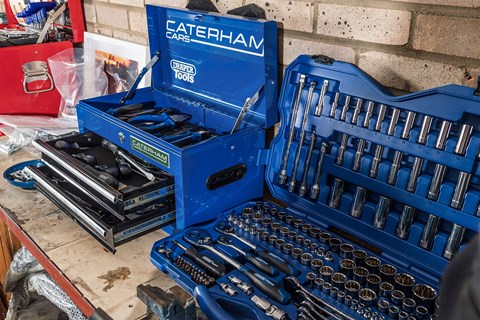
The DIY Caterham build survival guide
1) Have space
You’ll need a clear garage in which to build the car – trying to do the job outside, in a British winter, doesn’t bear thinking about. But the dream would be plenty of additional space in which to carefully unpack all the boxes and lay out their contents – doing so would knock whole days off the build time.
2) Get the Draper kit
An investment at £474 but Draper’s kit will turn even the shabbiest tool collection into one ready for racecar assembly. Includes the all-important torque wrench, myriad sockets, an embarrassment of screwdrivers and the axle stands you’ll need to sit the car up while you build it.
3) Go carefully…
Much of the bodywork comes pre-painted and fitted to the chassis, so there’s potential for slipped-screwdriver disaster. Several assembly steps ask that you protect painted surfaces with tape and cardboard: you only ignore that advice once.
4) Use Derek
He’s patient, he knows everything, he’s always on standby at the other end of an email and he hides his despair at your ineptitude magnificently.
Logbook: Caterham Academy
Engine: 1595cc 16v 4-cyl, 125bhp @ 6100rpm, 119lb ft @ 5350rpm
Transmission: 5-speed manual, open differential, rear-wheel drive
Stats: 5.0sec 0-60mph, 122mph, n/a g/km CO2
Price as tested: £24,995 (for the car in kit form – price includes race season but excludes delivery, paint and tool kit)
Miles this month: 0
Fuel this month: n/a
Extra costs: £80 (engine hoist hire)
Read more Caterham reviews by CAR magazine